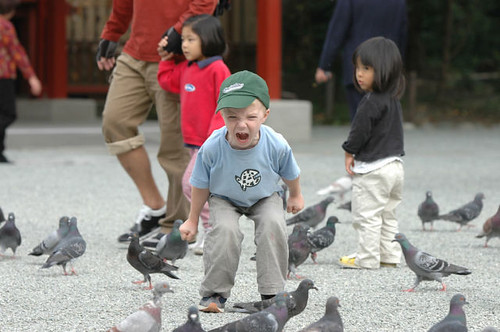Once upon a time there was a condition called Fetal Alcohol Syndrome (FAS). This was a condition with identifiable physical and psychological symptoms. It would sometimes occur in children from mothers who engaged in frequent and protracted binge drinking during pregnancy.
This diagnosis has now been changed to Fetal Alcohol Spectrum Disorder (FASD).
FAS has now become FASD
“dum dum, dum dum, dum dum...”
This is meant to be music from the movie, Jaws. I am building atmosphere here. Impending evil is about to descend on women.
FASD as it says, is a spectrum disorder which means it includes far greater numbers than FAS did. Now children only have to have a few of the diagnostic symptoms to be diagnosed with FASD. The ‘edges’ of the diagnosis are now more blurry, so a lot more children can be included in the spectrum.
Public health officials are now highlighting the dangers of alcohol by quoting this new condition called FASD and the ever increasing numbers of children effected.
And the impending evil?
The potential for over diagnosis is large, and the consequences of that over diagnosis on the self esteem if women is potentially severe.
In Australia we are quite prepared to label people with mental health conditions. Nowadays in Australia, any badly behaved child is seen to have ADD. The prescription rates of medication to children with ADD in Australia is amongst the highest in the world. There is significant over diagnosis. The same has happened with the diagnosis of a drug induced psychosis. I discuss this in my new book - Working with drug and alcohol users - and how there is over diagnosis on a large scale for a number of reasons.
In Australia we are now told by public health officials that there is no safe drinking level for women during pregnancy. Even a little alcohol consumption by a pregnant woman is considered dangerous to the child and it can cause all sorts of brain damage leading to low IQ, speech disorders, coordination problems and so forth.
A study by Jones and Streissguth (2010) looked at the children of alcoholic mothers and it found that 32% were born with FAS. A shocking statistic indeed for these children born to mothers who drank very heavily all through the pregnancy. However this means that 68% of children born to heavily drinking mothers did not get FAS. A significant majority of children born to women who consumed large quantities of alcohol did not get FAS.
But public health officials tell us there is no safe level of alcohol consumption for pregnant women, not even the odd glass of wine. The potential for over diagnosis is large especially now we have a spectrum disorder diagnosis.
I am a psychologist who has spent 25 years doing neuropsychological investigations of children who are brought to me for a variety of reasons. Often the child is not doing well academically at school and the parents want a neuropsycholigcal assessment done to find out what is going on. Lots of psychologists do the same sort of thing.
Typically the parents are asked many questions about the child’s development, any problems during pregnancy, was it a forceps delivery and so forth and now with FASD mothers will be asked if they drank alcohol during pregnancy. The child is then given an IQ test and one can begin to ascertain if there is any potential brain damage.
25% of children are above average IQ, 50% are average and 25% are below average IQ. That is how IQ tests are constructed. Some children are just born with a low IQ . There does not have to be a cause of brain damage. Some people are born with wonderful sporting ability and some are born such that if they run they trip over themselves. Some people are born with musical ability and some people when they sing the cat runs away. Some people are born with low IQ and some with high IQ. People are just naturally different in these ways.
If FASD goes the same way as the over diagnosis of ADD, then many women are going to suffer and suffer badly. A child who is performing poorly at school and mother wants to find out why will come into contact with mental health experts of all kinds -psychologists, psychiatrists, GPs, social workers, neurologists, pediatricians and so forth. She will be asked if she drank alcohol during pregnancy and if she says yes then there will be some who say directly to her that it was her drinking that caused the brain damage in the child. Even if she is not told directly she will see the look on some of the experts faces which says, “You should be ashamed of yourself”.
This will create guilt of the worst kind for the woman, “My selfish behaviour during pregnancy caused my child to be brain damaged” she may think. A woman living with that kind of guilt for years is going to have her self esteem eroded significantly. She listens to public health officials tell her that any alcohol consumption is dangerous for the child. They don’t tell her about studies which showed 68% of children did not get FAS from alcoholic mothers. They don’t tell her that sometimes children are just born with a low IQ and it was not her alcohol consumption that caused it. There are going to be many times when a woman is completely not at fault but will suffer years of this terrible guilt.
Society likes the temperate woman.
Even if she didn’t drink she may still suffer prejudice. If the child is performing poorly and she is asked if she drank and she says no there are going to be those who will still think, “Not only is she to blame because she probably did drink but now she is also lying about it.” If the FASD diagnosis becomes over used like ADD has, she is going to come up against prejudice like this from all sorts of people including family and friends. Even the husband may think such things because when she was pregnant and they socialized he always got too inebriated to remember if he saw her drinking.
Again from the Jones and Streissguth (2010) studies, they state:
“The developmental profile of the child with foetal alcohol spectrum disorders is variable, and the severity of presentation is not necessarily indicative of the severity of impairment (Stratton et al., 1996). Some children will not present any observable characteristics of FASD; their symptoms will be purely behavioural.”
“Children with foetal alcohol spectrum disorders may score within normal limits on measures of IQ, appear physically mature and give the appearance of functioning at a level consistent with their chronological age.”
In other words they don’t know clearly, it is inconsistent and it at times is going to involve guess work for the diagnosis of FASD. What it does mean is that with a diagnosis like this the potential for over diagnosis is very real and potentially large as could be the sexism and prejudice against women that may go along with it. Then there is also the possibility of years of guilt women could suffer when the child’s lower IQ has nothing to do with her alcohol consumption.
Women need to nip this in the bud before the diagnosis of FASD gets out of control like ADD has. With public health officials starting to say that any alcohol consumption during pregnancy is dangerous. These people need to be questioned on making such public health statements as this potentially new form of sexism evolves.
Graffiti






























